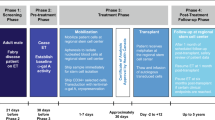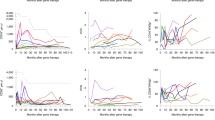Abstract
A deficiency in α-galactosidase A (α-gal A) activity causes Fabry disease. Virus-based delivery of genes can correct cells and establish a sustained supply of therapeutic proteins. Recombinant lentiviral vectors (LVs) show promise in this context. We first demonstrate LV-mediated marking of peripheral blood (PB) cells by transduction/transplantation of hematopoietic stem/progenitor cells. Stable enGFP expression was observed in PB for 37 weeks. Next, we transplanted Fabry mice with bone marrow mononuclear cells (BMMNCs) transduced a single time with a LV encoding the human α-gal A cDNA. Sustained expression of functional α-gal A in Fabry mice was observed over 24 weeks. Plasma α-gal A activity from treated Fabry mice was two-fold higher than wild-type controls. Increased α-gal A activity, often to supra-normal levels, and reduction of globotriaosylceramide, a glycolipid that accumulates in Fabry disease, was observed in all organs assessed. In secondary bone marrow transplantations, Fabry mice showed multilineage marking of PB, splenocytes and BMMNCs, along with therapeutic levels of α-gal A activity in plasma and organs over 20 weeks. Lastly, we transduced mobilized PB CD34+ cells from a Fabry patient and observed corresponding enzymatic increases. Thus a single LV-mediated transduction of primitive hematopoietic cells can result in sustained correction for Fabry disease.
This is a preview of subscription content, access via your institution
Access options
Subscribe to this journal
Receive 12 print issues and online access
$259.00 per year
only $21.58 per issue
Buy this article
- Purchase on Springer Link
- Instant access to full article PDF
Prices may be subject to local taxes which are calculated during checkout






Similar content being viewed by others
References
Brady RO, Gal AE, Bradley RM, Martensson E, Warshaw AL, Laster L . Enzymatic defect in Fabry's disease. Ceramidetrihexosidase deficiency. N Engl J Med 1967; 276: 1163–1167.
Desnick RJ, Ioannou YA, Eng CM . Fabry disease. In: Scriver CR, Beaudet AL, Sly WS, Valle D (eds). The Metabolic and Molecular Bases of Inherited Disease. McGraw-Hill Inc.: New York, 2001, pp 3733–3774.
Garman SC, Garboczi DN . The molecular defect leading to Fabry disease: structure of human α-galactosidase. J Mol Biol 2004; 337: 319–335.
Nakao S, Takenaka T, Maeda M, Kodama C, Tanaka A, Tahara M et al. An atypical variant of Fabry's disease in men with left ventricular hypertrophy. N Engl J Med 1995; 333: 288–293.
Schiffmann R, Kopp JB, Austin III HA, Sabnis S, Moore DF, Weibel T et al. Enzyme replacement therapy in Fabry disease: a randomized controlled trial. JAMA 2001; 285: 2743–2749.
Eng CM, Guffon N, Wilcox WR, Germain DP, Lee P, Waldek S et al. Safety and efficacy of recombinant human α-galactosidase A – replacement therapy in Fabry's disease. N Engl J Med 2001; 345: 9–16.
Staba SL, Escolar ML, Poe M, Kim Y, Martin PL, Szabolcs P et al. Cord-blood transplants from unrelated donors in patients with Hurler's syndrome. N Engl J Med 2004; 350: 1960–1969.
Peters C, Charnas LR, Tan Y, Ziegler RS, Shapiro EG, DeFor T et al. Cerebral X-linked adrenoleukodystrophy: the international hematopoietic cell transplantation experience from 1982 to 1999. Blood 2004; 104: 881–888.
Krivit W, Peters C, Shapiro EG . Bone marrow transplantation as effective treatment of central nervous system disease in globoid cell leukodystrophy, metachromatic leukodystrophy, adrenoleukodystrophy, mannosidosis, fucosidosis, aspartylglucosaminuria, Hurler, Maroteaux-Lamy, and Sly syndromes, and Gaucher disease type III. Curr Opin Neurol 1999; 12: 167–176.
Biffi A, De Palma M, Quattrini A, Del Carro U, Amadio S, Visigalli I et al. Correction of metachromatic leukodystrophy in the mouse model by transplantation of genetically modified hematopoietic stem cells. J Clin Invest 2004; 113: 1118–1129.
Medin JA, Tudor M, Simovitch R, Quirk JM, Jacobson S, Murray GJ et al. Correction in trans for Fabry disease: Expression, secretion, and uptake of α-galactosidase A in patient-derived cells driven by a high-titer recombinant retroviral vector. Proc Natl Acad Sci USA 1996; 93: 7917–7922.
Takenaka T, Qin G, Brady RO, Medin JA . Circulating α-galactosidase A derived from transduced bone marrow cells: relevance for corrective gene transfer for Fabry disease. Hum Gene Ther 1999; 10: 1931–1939.
Takenaka T, Murray GJ, Qin G, Quirk JM, Ohshima T, Qasba P et al. Long-term enzyme correction and lipid reduction in multiple organs of primary and secondary transplanted Fabry mice receiving transduced bone marrow cells. Proc Natl Acad Sci USA 2000; 97: 7515–7520.
Qin G, Takenaka T, Telsch K, Kelley L, Howard T, Levade T et al. Preselective gene therapy for Fabry disease. Proc Natl Acad Sci USA 2001; 98: 3428–3433.
Dunbar CE, Kohn DB, Schiffmann R, Barton NW, Nolta JA, Esplin JA et al. Retroviral transfer of the glucocerebrosidase gene into CD34+ cells from patients with Gaucher disease: in vivo detection of transduced cells without myeloablation. Hum Gene Ther 1998; 9: 2629–2640.
Naldini L . Lentiviruses as gene transfer agents for delivery to non-dividing cells. Curr Opin Biotechnol 1998; 9: 457–463.
Guenechea G, Gan OI, Inamitsu T, Dorrell C, Pereira DS, Kelly M et al. Transduction of human CD34+CD38− bone marrow and cord blood-derived SCID-repopulating cells with third-generation lentiviral vectors. Mol Ther 2000; 1: 566–577.
Hanawa H, Hematti P, Keyvanfar K, Metzger ME, Krouse A, Donahue RE et al. Efficient gene transfer into rhesus repopulating hematopoietic stem cells using a simian immunodeficiency virus-based lentiviral vector system. Blood 2004; 103: 4062–4069.
Yoshimitsu M, Sato T, Tao K, Walia JS, Rasaiah VI, Sleep GT et al. Bioluminescent imaging of a marking transgene and correction of Fabry mice by neonatal injection of recombinant lentiviral vectors. Proc Natl Acad Sci USA 2004; 101: 16909–16914.
Siatskas C, Underwood J, Ramezani A, Hawley RG, Medin JA . Specific pharmacological dimerization of KDR in lentivirally transduced human hematopoietic cells activates antiapoptotic and proliferative mechanisms. FASEB J 2005; 19: 1752–1754.
Ohshima T, Murray GJ, Swaim WD, Longenecker G, Quirk JM, Cardarelli CO et al. α-Galactosidase A deficient mice: a model of Fabry disease. Proc Natl Acad Sci USA 1997; 94: 2540–2544.
Ioannou YA, Zeidner KM, Gordon RE, Desnick RJ . Fabry disease: preclinical studies demonstrate the effectiveness of α-galactosidase A replacement in enzyme-deficient mice. Am J Hum Genet 2001; 68: 14–25.
Jung SC, Han IP, Limaye A, Xu R, Gelderman MP, Zerfas P et al. Adeno-associated viral vector-mediated gene transfer results in long-term enzymatic and functional correction in multiple organs of Fabry mice. Proc Natl Acad Sci USA 2001; 98: 2676–2681.
Moser HW, Linke T, Fensom AH, Levade T, Sandhoff K . Acid ceramidase deficiency: Farber lipogranulomatosis. In: Scriver CR, Beaudet AL, Sly WS, Valle D (eds). The Metabolic and Molecular Bases of Inherited Disease. McGraw-Hill Inc.: New York, 2001, pp 3573–3588.
Medin JA, Takenaka T, Carpentier S, Garcia V, Basile JP, Segui B et al. Retrovirus-mediated correction of the metabolic defect in cultured Farber disease cells. Hum Gene Ther 1999; 10: 1321–1329.
Mauch P, Hellman S . Loss of hematopoietic stem cell self-renewal after bone marrow transplantation. Blood 1989; 74: 872–875.
Takenaka T, Hendrickson CS, Tworek DM, Tudor M, Schiffmann R, Brady RO et al. Enzymatic and functional correction along with long-term enzyme secretion from transduced bone marrow hematopoietic stem/progenitor and stromal cells derived from patients with Fabry disease. Exp Hematol 1999; 27: 1149–1159.
Ailles L, Schmidt M, Santoni de Sio FR, Glimm H, Cavalieri S, Bruno S et al. Molecular evidence of lentiviral vector-mediated gene transfer into human self-renewing, multi-potent, long-term NOD/SCID repopulating hematopoietic cells. Mol Ther 2002; 5: 615–626.
MacDermot KD, Holmes A, Miners AH . Anderson–Fabry disease: clinical manifestations and impact of disease in a cohort of 98 hemizygous males. J Med Genet 2001; 38: 750–760.
Li Z, Dullmann J, Schiedlmeier B, Schmidt M, von Kalle C, Meyer J et al. Murine leukemia induced by retroviral gene marking. Science 2002; 296: 497.
Takahashi H, Hirai Y, Migita M, Seino Y, Fukuda Y, Sakuraba H et al. Long-term systemic therapy of Fabry disease in a knockout mouse by adeno-associated virus-mediated muscle-directed gene transfer. Proc Natl Acad Sci USA 2002; 99: 13777–137872.
Zielger RJ, Lonning SM, Armentano D, Li C, Souza DW, Cherry M et al. AAV2 vector harboring a liver-restricted promoter facilitates sustained expression of therapeutic levels of α-galactosidase A and induction of immune tolerance in Fabry mice. Mol Ther 2004; 9: 231–240.
Przybylska M, Wu IH, Zhao H, Ziegler RJ, Tousignant JD, Desnick RJ et al. Partial correction of the α-galactosidase A deficiency and reduction of glycolipid storage in Fabry mice using synthetic vectors. J Gene Med 2004; 6: 85–92.
Kase R, Simmoto M, Itoh K, Utsumi K, Kotani M, Taya C et al. Immunohistochemical characterization of transgenic mice highly expressing human lysosomal α-galactosidase. Biochim Biophys Acta 1998; 1406: 260–266.
Hacein-Bey-Abina S, Le Deist F, Carlier F, Bouneaud C, Hue C, De Villartay JP et al. Sustained correction of X-linked severe combined immunodeficiency by ex vivo gene therapy. N Engl J Med 2002; 346: 1185–1193.
Aiuti A, Slavin S, Aker M, Ficara F, Deola S, Mortellaro A et al. Correction of ADA-SCID by stem cell gene therapy combined with nonmyeloablative conditioning. Science 2002; 296: 2410–2413.
Gasper HB, Parsley KL, Howe S, King D, Gilmour KC, Sinclair J et al. Gene therapy of X-linked severe combined immunodeficiency by use of a pseudotyped gammaretroviral vector. Lancet 2004; 364: 2181–2187.
Hacein-Bey-Abina S, von Kalle C, Schmidt M, Le Deist F, Wulffraat N, McIntyre E et al. A serious adverse event after successful gene therapy for X-linked severe combined immunodeficiency. N Engl J Med 2003; 348: 255–256.
Hacein-Bey-Abina S, von Kalle C, Schmidt M, McCormack MP, Wulffraat N, Leboulch P et al. LMO2-associated clonal T cell proliferation in two patients after gene therapy for SCID-X1. Science 2003; 302: 415–419.
Schroder AR, Shinn P, Chen H, Berry C, Ecker JR, Bushman F et al. HIV-1 integration in the human genome favors active genes and local hotspots. Cell 2002; 110: 521–529.
Wu X, Li Y, Crise B, Burgess SM . Transcription start regions in the human genome are favored targets for MLV integration. Science 2003; 300: 1749–1751.
Kim EY, Hong YB, Lai Z, Kim HJ, Cho YH, Brady RO et al. Expression and secretion of human glucocerebrosidase mediated by recombinant lentivirus vectors in vitro and in vivo: implications for gene therapy of Gaucher disease. Biochem Biophys Res Commun 2004; 318: 381–390.
Hofling AA, Devine S, Vogler C, Sands MS . Human CD34+ hematopoietic progenitor cell-directed lentiviral-mediated gene therapy in a xenotransplantation model of lysosomal storage disease. Mol Ther 2004; 9: 856–865.
Sambrook J, Russell DW . Molecular cloning. A laboratory manual. Cold Spring Harbor Laboratory Press: Cold Spring Harbor, NY, 2001.
Tanaka T, Suda T, Suda J, Inoue T, Hirabayashi Y, Hirai H et al. Stimulatory effects of G-CSF on colony-forming units-spleen (CFU-S) differentiation and pre-CFU-S proliferation in mice. Blood 1991; 77: 2597–2602.
Acknowledgements
We thank Armando Poeppl and Gillian Sleep for technical assistance. This work was supported in part by NIH Grant HL70569 to JAM and a Roscoe Brady Genetic Diseases Fellowship to MY from the National Organization of Rare Diseases, Danbury, CT, USA.
Author information
Authors and Affiliations
Corresponding author
Rights and permissions
About this article
Cite this article
Yoshimitsu, M., Higuchi, K., Ramsubir, S. et al. Efficient correction of Fabry mice and patient cells mediated by lentiviral transduction of hematopoietic stem/progenitor cells. Gene Ther 14, 256–265 (2007). https://doi.org/10.1038/sj.gt.3302839
Received:
Revised:
Accepted:
Published:
Issue Date:
DOI: https://doi.org/10.1038/sj.gt.3302839
Keywords
This article is cited by
-
Essential thrombocytosis attributed to JAK2-T875N germline mutation
International Journal of Hematology (2019)
-
Engineered human Tmpk fused with truncated cell-surface markers: versatile cell-fate control safety cassettes
Gene Therapy (2013)
-
Gene Therapy for Fabry Disease: A Review of the Literature
BioDrugs (2013)
-
Lentivector Transduction Improves Outcomes Over Transplantation of Human HSCs Alone in NOD/SCID/Fabry Mice
Molecular Therapy (2012)
-
Treatment of adult MPSI mouse brains with IDUA-expressing mesenchymal stem cells decreases GAG deposition and improves exploratory behavior
Genetic Vaccines and Therapy (2012)



